Australia So Much to See
Copyright (C) 2013 AustraliaSoMuchtoSee.com. All reights reserved


Denmark in the South West of WA; in and around the town
Denmark, a beautiful town situated on the Denmark River and Wilson Inlet
The town on Denmark is situated on the Denmark River and has spread along the edge of Wilson Inlet with restaurants, wineries and
other tourist orientated businesses up in hills giving views to the Inlet and the ocean.
We stayed at the Rivermouth Caravan Park as
this is a lovely location to enjoy views across the inlet and walks along the river and use as a base for drives to the many places
of interest around the town and nearby coastline.
For those with boats, Bay Snapper are a good catch in the Inlet. Suitable for kayaking or yachting most of the time, the Inlet can become choppy rather quickly in the wind.
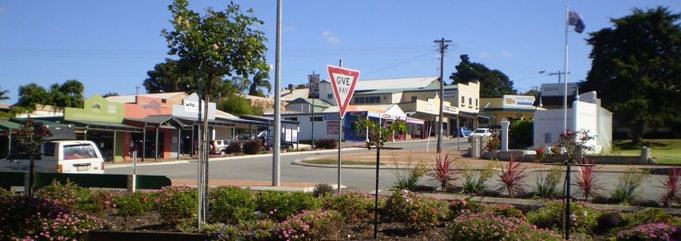
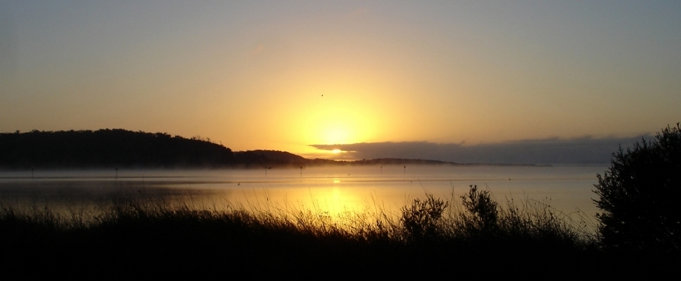
The former railway bridge is part of the trail which runs from Peaceful Bay along the old railway line and after crossing the river
for a further 12 kilometres to meet the Hay River. The trail is open to walkers and cyclists and parts of the trail for
horse riders. Dogs on leads are permitted. After the completion of bridges over the Kent and Bow Rivers the trail will
follow the full length of the original railway track from Nornalup to Denmark and the Hay River. See more from our 2017 visit.
In the still of an early misty morning, the rivermouth and inlet at this point are amongst my favourite photography places. Swans and Pelicans are amongst the many birds that can be seen as the sun rises across the usually glassy waters of early morning.
History of the Nornalup to Denmark Railway extracted from Nornalup Denmark Heritage Rail Trail
In 1895 the Millar brothers secured
private leases for 20,000 acres of old growth Karri forest. The Millars exploited the forests so rapidly that they cleared the local
forests within ten years. By 1905 they had closed the mill and the town was almost deserted. The Western Australian Government bought
the Millars property, town, land and railways. The railway line to Albany became a commercial line in 1908/9 after the land was offered
for farms and housing. The Western Australian Government Group Settlement scheme of 1923 saw the migration of many new families to
the district. The Denmark to Nornalup Railway was the only completed stage of the planned Denmark to Big Brook (Pemberton) Railway.
The construction of the full line would have connected Denmark to the timber mills of the Pemberton area and completed the link to
Bunbury.
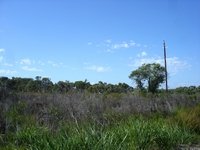
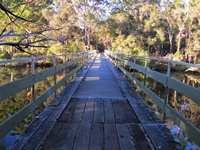
Work on the Denmark to Nornalup line commenced in 1926, employed 300 men and took nearly three years to complete. At the time of opening,
the line serviced 900 people on 15 group settlements along the line. The railway played a central role in the lives of the group settlers.
Two trains a week ran, which serviced passengers, collected farm produce and delivered goods and supplies. The history of the group
settlement scheme is a sad one, with a lot of hardship and failure.
The Denmark to Nornalup Railway Line was closed, on economic grounds, on the 30th September 1957.
The Bibbulmun Track is a 1,000 kilometre walk trail from Perth to Albany with spurs to access towns and features along the way. Close to Wilson Inlet we walked a small section in which the bushland and swampland defied the proximity to the town and to the houses
close to the edge of the inlet.
Mount Lindesay National Park is 24 kilometres from the town and was established as a park in 2004. A ten kilometre return walk
trail to the summit is a relatively easy climb. We start out through woodland, then the vegetation changes to open short scrub
with lots of wildflowers.
Even part way up the trail there are good views across farms and forest.
With an easy trail to the summit on granite rock from this point, there is a large relatively flat area with views to the coast, across
the farms and forest, and to Mount Manypeaks, the Stirling Ranges and the Porongurups.
Soon glimpses the inlet and ocean come into view from a granite platform with a wide vista.
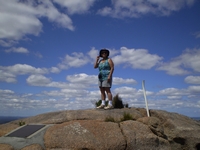
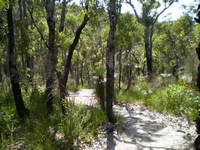
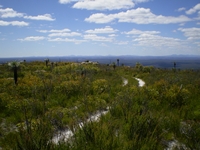
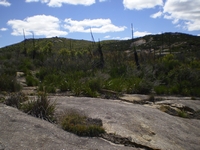
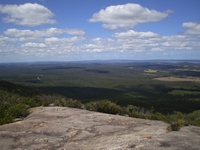
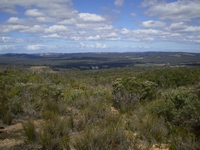
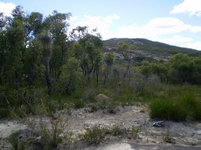
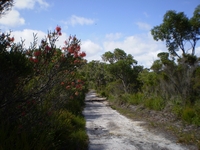
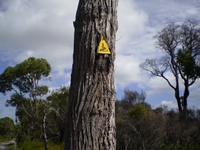
On the central rock the peak is marked and a plaque tells the history of exploration and naming of features in the area.
Dr Thomas Braidwood Wilson R.N. (1972 to 1843) explored this area from Albany in December 1829. He was accompanied
by Mokare (Aboriginal guide), John Kent (Administration), Private Gogh (39th Regiment) and two un-named convicts.
After discovering
the Kent River (named after John Kent), he named Mount Lindesay (after Colonel P. Lindesay of the 39th Regiment) and from its summit
on Wednesday 9th December 1829, he honoured three surveyors general by naming Mount Roe (after J.S. Roe of Western Australia), Mount
Frankland (after G. Frankland of Tasmania) and Mount Mitchell (after Major T. Mitchell of New South Wales).
During the next
two days, Dr Wilson named the Denmark River (after Dr Alexander Denmark R.N.), Mount Hallowell (after Admiral Hallowell R.N.), Mount Shadforth (after
Lieutenant Colonel T. Shadforth of the 57th Regiment New South Wales) and the Hay River (after R.W. Hay, Undersecretary for the Colonies).
FromMount Lindesay, Dr Wilson discovered the inlet which was later named Wilson Inlet in his honour by Governor Stirling.
On the hills overlooking the town you will find a number of wineries, restaurants, accommodation and other businesses catering
to the interests of tourists.
I can highly recommend the Sunday buffet breakfast at Southern End Restaurant, Denmark Brew
and Ales with a huge choice of food while dining overlooking farmlands across to the ocean.
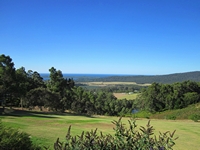
High on the hill with views to the ocean and William Bay, this animal experience is particularly good for children as they can feed
the animals including bottle feeding lambs, calves and joeys at set times of the day.
Numerous animals large and small, including
two koalas, a camel, a buffalo and a donkey. See the Pentland website. See more photos from 2017
Mount Shadforth Lookout
Take a short drive from Mount Shadforth Drive via Mohr Drive to Mount Shadforth Lookout where a picnic
shelter has an outlook over Wilson Inlet. A plaque dedicated to the pioneering farmers is displayed.
Extract:
This viewing shelter is dedicated to Charles and Winifred Mohr who settled this farm in 1924 and to William and Kathleen
Middleton, Kathleen being their daughter. Donated to the Denmark people by Max and Phillip Middleton in fond memory of their
Parents and Grandparents.
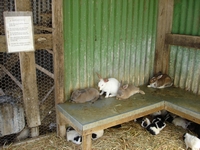
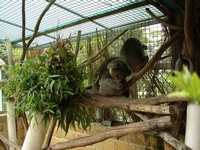
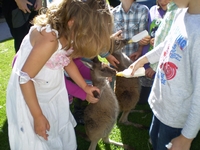
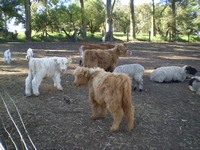
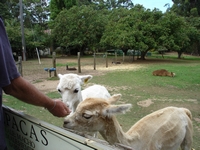
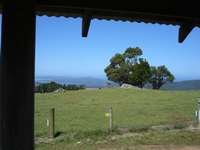
A hutch full of rabbits, guinea pigs, ferrets and other small animals and poultry.
Visitors can make friends with all the animals at Pentland. Here freshly shorn Alpacas are enjoying the offering.
Children can enjoy the hands on experience of bottle feeding lambs, kids, calves and joeys at 3 pm each afternoon.
Scottish Highland calves, lambs and kids; some of the bottle fed babies
Due to their low energy diet of leaves, koalas spend much of their time sleeping. See the koalas fed at 10 am each day.
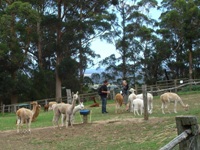
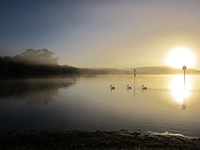
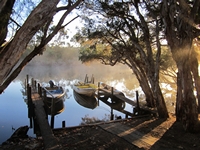
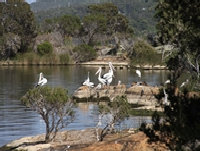
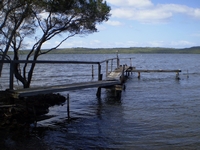
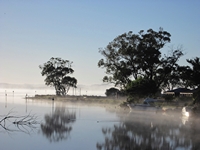
Around Wilson Inlet and the Denmark Rivermouth
The beauty of the inlet and river can be enjoyed from this selection of photos.
See more photos on the next page



























